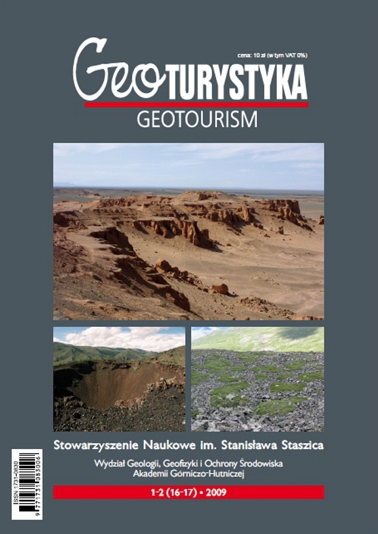Sandstone-conglomerate rocky forms – more than a tourist attraction
DOI:
https://doi.org/10.7494/geotour.2009.16-17.49Keywords:
geotourism, sandstone-conglomerate rockies, Mushroom Stone, Istebna Beds, flysch, sedimentation, Outer Carpathians, weathering structuresAbstract
Natural, thrown open to the sightseeing rockies are undoubtedly a tourist attraction, but furthermore they constitute a precious source of geological and geomorphological information. A special scientific-cognitive and teaching value of the rocky forms is based on the possibility of carrying out direct observations on the character of deposits and on shaping these forms by exogenic processes. A good example of the rocky forms with such values is represented by sandstone-conglomerate rockies in the Outer Carpathians. One of the regions where such rockies occur is the Wiśnicz Foothil, where, among others, the Brodziński Stones (after a poet), the Mushroom Stone (after a mushroom-like shape) and the Chronowskie Tors (after the Chronów town) are localized. The Mushroom Stone serves to demonstrate general, common features of the origin of the rocky forms from the Istebna Beds (the Istebna Formation) observed by the author also in the Moravian Beskid Mts. and Silesian Beskid Mts. and the Small Beskid Mts. Epigenetic arcade structures, cellular structures (honey comb structures) and bowl structures form characteristic relief of rockies. The rocky forms have a complex origin, resulting from many interconnected factors and processes that develop in time with various intensity.Downloads
References
Alexandrowicz, Z., 1978. Skałki piaskowcowe zachodnich Karpat Fliszowych. Komisja Nauk Geologicznych, Oddział Kraków, Prace Geologiczne, 113: 1-86.
Alexandrowicz, Z., 1987. Przyroda nieożywiona Czarnorzeckiego Parku Krajobrazowego. Ochrona Przyrody, 45: 263-293.
Alexandrowicz, Z., 2008. Sandstone rocky forms in Polish Carpathians attractive for education and tourism. Przegląd Geologiczny, 56, 8/1: 680-687.
Alexandrowicz, Z, Urban, J., 2000. Chronione obszary i obiekty, rezerwaty przyrody, Kamień Grzyb. W: Alexandrowicz, Z., Poprawa D. (red), Ochrona georóżnorodności w polskich Karpatach z mapą 1:400 000, Państwowy Instytut Geologiczny, Warszawa: 87-88.
Anioł, C., 2004. Lipnica Murowana przewodnik. Wyd. Arete II, Sanok, 104 pp.
Boxerman, J.Z., 2005. The Evolutionary Cycle of the Tafoni Weathering Pattern on Sandstone at Bean Hollow Beach, Northern California. Geological Society of America Sectional Meeting, San Jose, CA; April 2005.
Cieszkowski, M., Golonka, J., Krobicki, M., Ślączka, A., Oszczypko, N., Waśkowska, A., Wendorff, M., 2009. The Northern Carpathians plate tectonic evolutionary stages and origin of olistoliths and olistostromes. Geodinamica Acta, 22, 1/3: 101-126.
Dadlez, R., Jaroszewski, W., 1994. Tektonika, PWN, Warszawa: 215-269.
Gawlikowska, E., 2008. Stołowe (Table) Mountains. Przegląd Geologiczny, 56, 8/1: 699-705.
Goudie, A.S., Viles, H., 2008. Weathering Processes and Forms. In: Burt, T.P., Chorley, R.J., Brunsden, D., Cox, N.J., Goudie, A.S., Quaternary and Recent Processes and Forms. Landforms or the Development of Geomorphology. 4. Geological Society: 129-164.
Huggett, R.J., 2007. Fundamentals of geomorphology, 2nd. edition. Ed. Routledge, New York, 458 pp.
Kicińska, A., 2009. Struktury komórkowe w obrębie piaskowców magurskich na przykładzie Diabelskich Ścian (pasmo Jaworzyny Krynickiej). Cellular structures in the Magura sandstones – an example from the Devil’s Wall (the Jaworzyna Krynicka Range) (in Polish, English abstract, explanations and summary). Geologia (Kwartalnik AGH), Kraków, 35, 2: 201-215.
Migoń, P., Pijet-Migoń, E., 2006. Czeski Raj – nowy europejski geopark. The Bohemian Paradise – a new european geopark. Geoturystyka, 4(7): 21-32.
Mustoe, G.E., 1982. The Origin of Honeycomb Weathering. Geology Society of America Bulletin, 93: 108-115.
Nescieruk, P., Szydło, A., 2003. Rozwój i pozycja warstw istebniańskich w Beskidzie Morawsko-Śląskim. Sbornik vedeckych praci Vysoke skoly banske, 49: 74-75.
Picha, F.J., Stráník, Z., Krejčí, O., 2006. Geology and Hydrocarbon Resources of the Outer Western Carpathians and Their Foreland, Czech Republic. W: Golonka J., Picha, F. J. (eds), The Carpathians and their foreland: Geology and hydrocarbon resources: AAPG Memoir 84: 49-175.
Radwanek-Bąk, B. (red), 2009. Georóżnorodność i atrakcje geoturystyczne województwa małopolskiego – Przewodnik. Dep. Rol. i Geol. UM Woj. Małopol., Zesp. Geol.; Państw. Inst. Geol. – Państw. Inst. Badaw.; Wyd. Kart. „Compass”, 60 pp.
Reading, H.G., Richards, M., 1994. Turbidite systems in deep-water basin margins classified by grain size and feeder system. Bull. Am. Assoc. Petrol., 78, 5: 792-822.
Rodriguez-Navarro, C., Doehne, E., Eduardo, S., 1999. Origins of honeycomb weathering: The role of salts and wind. Geological Society of America Bulletin, 111, 8: 1250-1255.
Shanmugam, G., 2006. Deep – Water Processes and Facies Models: Implications for Sandstone Petroleum Reservoirs. Elsevier, Series Editor John Cubitt, Handbook of Petroleum Exploration and Production, 5: 1-476.
Skoczylas-Ciszewska, K., Burtan, J., 1954. Szczegółowa Mapa Geologiczna Polski, 1: 50 000, ark. M 34 – 77 B (Bochnia), Instytut Geologiczny, Wyd. Geol.
Słomka, T., 1995. Głębokomorska sedymentacja silikoklastyczna warstw godulskich Karpat. Pr. Geol. PAN, 139: 1-132.
Słomka, T., Kicińska-Świderska, A., 2004. Geoturystyka – podstawowe pojęcia, Geoturystyka, 1(1): 5-7.
Strzeboński, P., Słomka, T., 2007. Kaskady Rodła atrakcją geoturystyczną Beskidu Śląskiego. The Rodło Cascades as a geotouristic attraction of the Silesian Beskid Mts. (in Polish, English abstract, explanations and summary). Geoturystyka 1(8): 21-28.
Strzeboński, P., 2008. The „Mushroom Stone” – a geotouristic gemstone of the Wiśnicz-Lipnica Landscape Park (the Outer Western Carpathians, Poland (abstract). W: Słomka T. (ed.), Geotourism and mining heritage, 4nd International Conference Geotour 2008, 26-28.06. 2008, IAGt, AGH, Kraków, Poland: 68-69.
Unrug, R.,1963. Istebna Beds – a fluxoturbidity formation in the Carpathian Flysch, Ann. Soc. Geol. Pol., 33: 49-92.
Downloads
Published
Issue
Section
License

The content of the journal is freely available according to the Creative Commons License Attribution 4.0 International (CC BY 4.0).


